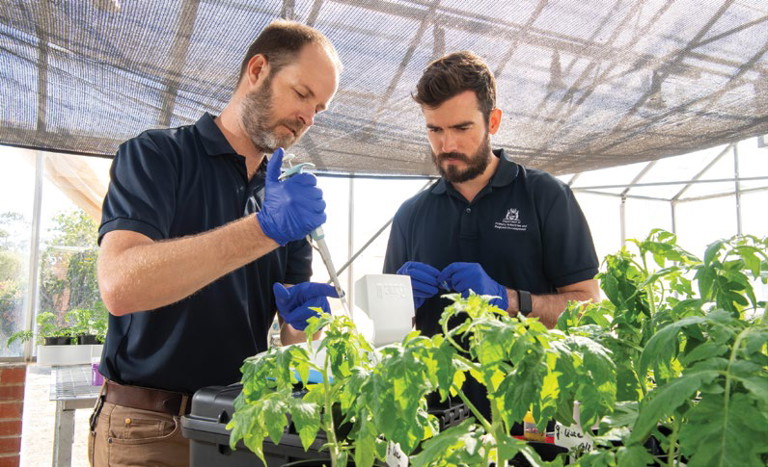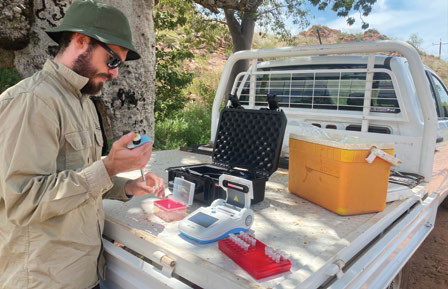Rapid fall armyworm identification assisted by LAMP technology
DR CRAIG WEBSTER LABORATORY SCIENTIST, DPIRD AND DR BEN CONGDON RESEARCH SCIENTIST, DPIRD

Craig Webster and Ben Congdon demonstrate the use of LAMP to detect fall armyworm in crops.
PHOTOS © DPIRD
Researchers at the Department of Primary Industries and Regional Development (DPIRD) have developed a new infield early warning system to detect a significant pest threat to grains and horticulture crops and help protect production and profitability.
Since fall armyworm (Spodoptera frugiperda), was first detected in northern Western Australia (WA) in 2020, it has rapidly spread across the State, most recently being detected in horticulture crops as far south as Gingin.
In an Australian first, DPIRD researchers Ben Congdon and Craig Webster used Loop-mediated isothermal AMPlification (LAMP) technology to make a new test that is able to rapidly identify fall armyworm. The test is accurate on all life stages, including all ages of caterpillars, which can be difficult to distinguish from similar species.
Research scientist Ben Congdon said the LAMP system was very rapid compared to laboratory-based tests and could identify fall armyworm at a molecular level in the field in under half an hour due to the LAMP machine being battery powered. The new technology keeps costs low by ensuring rapid results.
The test uses a small piece of the fall armyworm, mixed with water and buffers, and the portable LAMP machine processes it in the field to provide an accurate result.
The department tested the system in horticulture crops in the State’s north and validated its results with genomic sequencing undertaken in the lab to confirm the molecular diagnosis.
In spring, when the pest is active in vegetable crops elsewhere in the State, further infield validation will be carried out.
The LAMP fall armyworm test will generate far-reaching benefits to both horticulture and grains industries.
Senior research scientist and manager for Insect and Pest Management, Helen Spafford, said much was being learned about how best to control fall armyworm, including how it performs in different crops and environments.
“Confirmation of an established and potentially damaging population relies on the detection of early instar larvae in the crop, which is critical to make informed management decisions. As the LAMP test can be used on very young caterpillars, it enables decisions to be made rapidly,” Dr Spafford said.
“The new LAMP fall armyworm identification test will enable horticulture and grain growers to rapidly and cheaply identify the pest in their crops so they can take evasive action to protect production and optimise profitability.”
MORE INFORMATION
• Dr Ben Congdon, (08) 9368 3499 or email ben.congdon@dpird.wa.gov.au
• Dr Craig Webster, 0499 997 563 or email craig.webster@dpird.wa.gov.au
• Dr Helen Spafford, (08) 9166 4074 or email helen.spafford@dpird.wa.gov.au
Rapidly and cheaply identifies crop pests.
